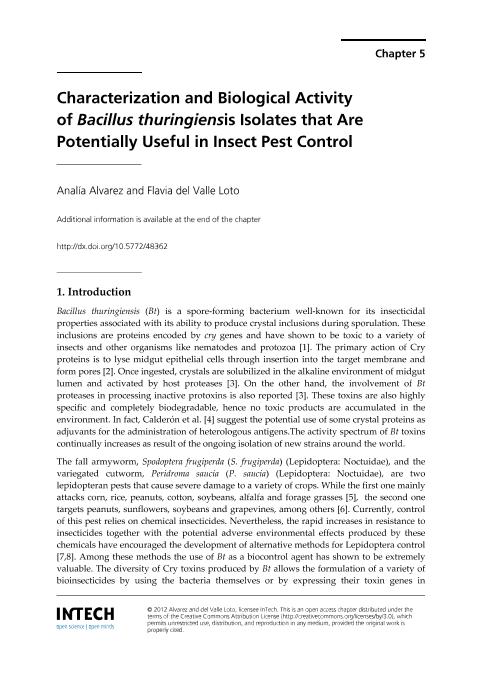Mostrar el registro sencillo del ítem
dc.contributor.author
Alvarez, Analia

dc.contributor.author
Loto, Flavia del Valle

dc.contributor.other
Lameed, Gbolagade Akeem
dc.date.available
2020-09-23T19:13:38Z
dc.date.issued
2012
dc.identifier.citation
Alvarez, Analia; Loto, Flavia del Valle; Characterization and Biological Activity of Bacillus thuringiensis Isolates that Are Potentially Useful in Insect Pest Control; IntechOpen; 2012; 133-152
dc.identifier.isbn
978-953-51-0718-7
dc.identifier.uri
http://hdl.handle.net/11336/114670
dc.description.abstract
Bacillus thuringiensis (Bt) is a spore-forming bacterium well-known for its insecticidal properties associated with its ability to produce crystal inclusions during sporulation. These inclusions are proteins encoded by cry genes and have shown to be toxic to a variety of insects and other organisms like nematodes and protozoa . The primary action of Cry proteins is to lyse midgut epithelial cells through insertion into the target membrane and form pores . Once ingested, crystals are solubilized in the alkaline environment of midgut lumen and activated by host proteases . On the other hand, the involvement of Bt proteases in processing inactive protoxins is also reported. These toxins are also highly specific and completely biodegradable, hence no toxic products are accumulated in the environment. In fact, Calderón et al. suggest the potential use of some crystal proteins as adjuvants for the administration of heterologous antigens.The activity spectrum of Bt toxins continually increases as result of the ongoing isolation of new strains around the world. The fall armyworm, Spodoptera frugiperda (S. frugiperda) (Lepidoptera: Noctuidae), and the variegated cutworm, Peridroma saucia (P. saucia) (Lepidoptera: Noctuidae), are two lepidopteran pests that cause severe damage to a variety of crops. While the first one mainly attacks corn, rice, peanuts, cotton, soybeans, alfalfa and forage grasses, the second one targets peanuts, sunflowers, soybeans and grapevines, among others . Currently, control of this pest relies on chemical insecticides. Nevertheless, the rapid increases in resistance to insecticides together with the potential adverse environmental effects produced by these chemicals have encouraged the development of alternative methods for Lepidoptera control . Among these methods the use of Bt as a biocontrol agent has shown to be extremely valuable. The diversity of Cry toxins produced by Bt allows the formulation of a variety of bioinsecticides by using the bacteria themselves or by expressing their toxin genes in transgenic plants. To date, many plant species have been genetically modified with cry genes, resulting in transgenic plants with a high level of resistance to insect . However, it has been reported that several pests have developed resistance against Cry proteins . The current approach used to delay evolution of resistance to transgenic crops uses a "high dose" and "refuge" strategy . In addition, it is important to use a combination of cry genes and/or other genes encoding insecticidal proteins within the same transgenic crop . Due to extensive use of transgenic crops in developing countries based on cry-type genes, there is a need for alternative cry gene sequences to meet the challenge of novel insect resistance . Crucial to this development is the identification of novel and more active strains with respect to insect pests of economically important crops. The cry genes of Bt strains are known to be related to their toxicity and identification of these genes by means of PCR has been used to characterize and predict insecticidal activity of the strains . Nevertheless, a more complete characterization should include alternative methods. Phenotypical analysis such as protein profile determination provides useful information for typing and comparative studies. The literature data report the possibility of using the whole-cell protein profile as a discriminating method with potency similar to RAPD with combined DNA patterns. However, there is not always a good correlation between these factors and insecticidal activity of Bt strains. In addition, there is a need to develop knowledge about the biological properties and diversity of Bt isolates since these data allow a better understanding of the biological factors that determine insecticidal properties. Extracellular factors such as phospholipases, proteases and chitinases have shown to contribute to insecticidal activity of Bt . During a screening programme of Bt isolates native to Argentina and toxic against Lepidoptera, several strains were characterized according to different biological parameters. In addition, promising isolates regarding their useful in biological control programmes -an environmentally safe technology of pest control- were exhaustively studied . The present work showed most relevant results obtained during a course of those investigations. The discovery of highly pathogenic isolates against devastating insect pests reveals the usefulness of screening studies for novel Bt strains.
dc.format
application/pdf
dc.language.iso
eng
dc.publisher
IntechOpen

dc.rights
info:eu-repo/semantics/openAccess
dc.rights.uri
https://creativecommons.org/licenses/by/2.5/ar/
dc.subject
THURINGIENSIS
dc.subject
SPODOPTERA
dc.subject
BIOCONTROL
dc.subject.classification
Biología Celular, Microbiología

dc.subject.classification
Ciencias Biológicas

dc.subject.classification
CIENCIAS NATURALES Y EXACTAS

dc.title
Characterization and Biological Activity of Bacillus thuringiensis Isolates that Are Potentially Useful in Insect Pest Control
dc.type
info:eu-repo/semantics/publishedVersion
dc.type
info:eu-repo/semantics/bookPart
dc.type
info:ar-repo/semantics/parte de libro
dc.date.updated
2020-05-19T18:56:23Z
dc.journal.pagination
133-152
dc.journal.pais
China

dc.journal.ciudad
Shenzhen
dc.description.fil
Fil: Alvarez, Analia. Consejo Nacional de Investigaciones Científicas y Técnicas. Centro Científico Tecnológico Conicet - Tucumán. Planta Piloto de Procesos Industriales Microbiológicos; Argentina
dc.description.fil
Fil: Loto, Flavia del Valle. Consejo Nacional de Investigaciones Científicas y Técnicas. Centro Científico Tecnológico Conicet - Tucumán. Planta Piloto de Procesos Industriales Microbiológicos; Argentina
dc.relation.alternativeid
info:eu-repo/semantics/altIdentifier/url/https://www.intechopen.com/books/biodiversity-enrichment-in-a-diverse-world/characterization-and-biological-activity-of-bacillus-thuringiensis-isolates-that-are-potentially-use
dc.relation.alternativeid
info:eu-repo/semantics/altIdentifier/doi/https://dx.doi.org/10.5772/48362
dc.conicet.paginas
510
dc.source.titulo
Biodiversity Enrichment in a Diverse World
Archivos asociados
